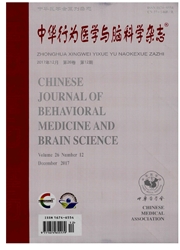

 中文摘要:
中文摘要:
目的探讨踏转轮运动训练对新生期大鼠反复惊厥所致学习能力损害的干预作用。方法生后6d(用P6表示,下同)的SD大鼠随机分成2组,反复惊厥组(Rs组)每日吸入三氟乙醚诱导惊厥发作1次,每次持续30min,连续6d;对照组同样操作但不吸入三氟乙醚。2组大鼠分别于P29~P35、P61-P67进行两次Y迷宫学习训练,检测大鼠的学习和记忆功能。期间,于P51-P56对2组进行踏转轮训练,每天1次,每次30min,连续6d。结果①学习能力测试:第1次Y-迷宫学习训练Rs组大鼠辨别学习达到标准的训练次数为(60.0±14.1)次,与对照组(37.5±17.2)次比较,差异具有显著性(t=2.69,P〈0.05);第2次Y-迷宫学习训练Rs组大鼠辨别学习达到标准的训练次数为(27.5±14.1)次,与对照组(21.0±11.01)次比较,差异无显著性(t=1.03,P〉0.05);2组第2次测试学习成绩均较第1次有显著改善,差异有显著性。②记忆保存测试:RS组与对照组2次测试结果差异无显著性(P〉0.05)。结论运动训练能显著改善新生期反复长时程惊厥对学习能力的损害。
 英文摘要:
英文摘要:
Objective To explore the long-term effects of neonatal seizures and physical exercise on learning and memory capacity of rats. Methods The SD rats were randomly divided into the recurrent-seizure group (RS) and the control group. The volatile agent flurothyl was used to induce 30 rain seizure attack. At postnatal day 6 ( P6 ), the recurrent seizures were induced once per day for consecutive 6 days. The rats in control group were placed into the container for an equal amount of time to their counterpart without exposure to flurothyl. At P29 - P35, P61 - P67, Y-maze test were performed to evaluate learning and memory capacity. During this time,at P51 - P56, the RS and control groups were submitted to an aerobic exercise program 30rain per day for consecutive 6 days. Results (1)Y-maze discrimination learning test: in the first Y-maze test, the trials to criterion in RS and control groups were 60 ± 14.1 and 37.5 ± 17.2 respectively ( t=2.69, P〈0.05 ) ; there was no significant difference between RS (27.5 ± 14.1 ) and control (21.0± 11.01 ) groups in the second Y-maze test. (2) Memory test : the trials to criterion between RS and control groups was not significantly different ( t = 1.03, P 〉 0.05 ). Conehmion Physical exercise improve the learning capacity of neonatal seizure-induced cognitive deficit.
 同期刊论文项目
同期刊论文项目
 同项目期刊论文
同项目期刊论文
 期刊信息
期刊信息
